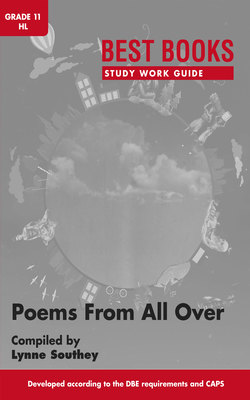Читать книгу Best Books Study Work Guide: Poems From All Over Gr 11 HL - Lynne Southey - Страница 18
The Second Coming by W.B. Yeats
Оглавление(See p. 29 in Poems From All Over)
| Title: | The title refers the Christian idea that Jesus, who is said to have ascended to heaven about two thousand years ago after his first coming, will come again. |
| Theme: | Some dire change is happening in the world. |
| Mood: | Grim |
Discussion
The poem starts with the image of a falcon whirling higher and higher into the sky until it can no longer hear its handler, the falconer. The man has lost control of the bird. He likens this to the state of the world where “anarchy”, chaos and lack of control related to the political situation, now reigns. (Remember that the poem was written a few years after the First World War.) The speaker speculates that something big is about to happen, such as the Second Coming of Jesus. And then he sees a huge beast, born out of the collective consciousness of the people, staggering towards Bethlehem, were Jesus was born.
The poem is divided into two stanzas, the first of eight lines describing the chaotic state of the world, and the second of fourteen lines anticipating some new order or more terrible chaos that will emerge in the world. The longer second stanza describing what the speaker caught a glimpse of speculates about the great beast appearing on earth and what it can mean.
The poem is packed with images and symbolism so that the twenty-two lines convey much more than they appear to. The meaning is richly dense.
Analysis
| Lines | Comment | |
| 1–8 | The falcon circles higher and higher until the falconer loses control of it. The speaker generalises from this that the old order on earth has gone, and left chaos in its place. | The drawing in your anthology gives you an idea of the shape of a gyre, turning further and further away in ever widening circles. Lines 3 to 6 describe horrific circumstances, implying wars and bloodshed, loss of life, lack of order, loss of innocence.Notice the repetition of “is loosed” (line 4) (is let loose) and the use of the passive voice. Who is doing this? Is it humanity to the world through our own actions and lack of control or is it circumstances? People have lost their “innocence” (line 6), and good people their “conviction” (line 7) of what is right, while the worst people are passionately intense. This reminds us of fanatics who see no evil in anything they do for their cause. |
| 9–17 | The speaker suggests that some great revelation is near. As he says this he sees coming from the consciousness of all men a huge image, which “troubles his sight”, so it is not a positive thing to see. From the desert a creature like the Great Sphinx of Giza in Egypt, comes slowly towards Bethlehem.There is no expression in the eyes except pitilessness, a lack of mercy, like the sun in the desert. The creature is moving slowly, frightening all the desert birds whose shadows pass over it. | Normally the Second Coming would refer to a renewal of faith and all the good that comes with it.The repetition of “The Second Coming” followed by the exclamation mark points to the wishful thinking in his first hopeful thought. However, it is the opposite that approaches, merciless, slow and huge. The birds are indignant at being disturbed, not accustomed to this monstrous being that has suddenly arisen. |
| 18–22 | The image fades in the darkness and the speaker is left with the knowledge that after a “stony sleep” of twenty centuries, a terrible creature has woken up from the nightmares caused by the upheavals that have been happening in the world (rocking its cradle). It is “slouching” (moving loosely with its great body drooping in a careless way). This is what is coming towards man, some terrible evil rather than some saviour. | The speaker is in darkness, which can signify ignorance or danger, and can no longer see the image, but he knows what it means. It is this that the chaos on earth has led to.Note the alliteration (repetition of initial consonants) in stony sleep that has been disturbed (“vexed to nightmare”) (line 20) by the turbulence on earth. The cradle signifies a baby (as Jesus was when he arrived) or the start of new life, in this case something evil. “[I]ts hour come round at last” (line 21) implies that the creature had been waiting to emerge, was there all the time. The notes in your anthology refer to “rough beast” as the anti-Christ, an opponent of Christ and all he stood for. Evil has won over good. |
Contextual questions
1.What tense is used in the first stanza and what is the effect? (3)
2.Tame falcons usually return to their handler, who wears a leather glove for them to perch on. Why do you think the poet uses the image of the falcon? (3)
3.Lines 3 and 4 are very well known. Explain how the meaning conveyed is linked to the first two lines. (4)
4.Look at the run-on line “and everywhere / The ceremony of innocence is drowned”. This is a powerful phrase. Discuss what gives it its impact. (5)
5.In what way is the “rough beast”, the anti-Christ, a suitable image to use for what the poet sees as happening in the world? (5)
(20)
| Enrichment activityChinua Achebe, a Nigerian writer, wrote a novel called Things Fall Apart, using the phrase from the poem. The subject is the political situation in Nigeria. You might like to read it. (Things Fall Apart is the prescribed setwork for Grade 11 Home Language learners.) |
